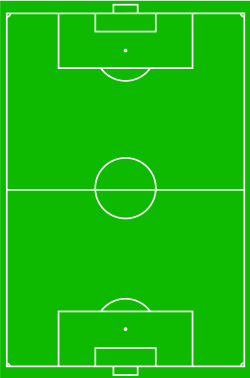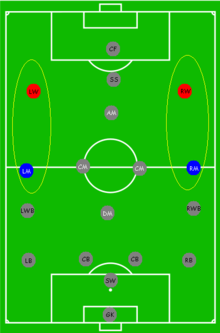Midfielder

A midfielder is an association football position.[1] Midfielders are generally positioned on the field between their team's defense and forwards. Some midfielders play a more defensive role, while others blur the boundaries between midfielders and forwards. The number of midfielders on the team and their assigned roles depends on the team's formation; the collective group of these players on the field is sometimes referred to as the midfield.[2]
Most managers assign at least one midfielder to disrupt the opposing team's attacks, while others may be tasked with creating goals, or have equal responsibilities between attack and defence. Midfielders are the players who typically travel the greatest distance during a match.[3]
Central midfielder

Central or centre midfielders are players whose role is divided roughly equally between attack and defense. When in possession of the ball, central midfielders will seek to pass the ball to the team's attacking midfielders and forwards. When the team is not in possession, central midfielders will help to defend by pressing opposition ball-carriers and taking up position in front of the team's defensive line. These players may also contribute to the team's offense by making forward runs towards the opposition's penalty area and attempting shots on goal themselves. On defense, central midfielders may additionally attempt tackles, interceptions and clearances.[1]
Box-to-box midfielder
The term box-to-box midfielder refers to players who possess good mobility and are skilled at both defending and attacking.[4] Such footballers are therefore useful in both their own and their opponents' penalty boxes.
Wide midfielder
Left and right midfielders have a role similar to that of central midfielders, but are positioned closer to the touchlines of the pitch. A notable example of a right midfielder is David Beckham.[5] The pre-eminent modern formations in which right, central and left midfielders are all present are the 4-4-2 and the 4-4-1-1.[6]
Defensive midfielder
Defensive or holding midfielders are midfield players with a primarily defensive role. These players may be assigned to defend zonally in front of their team's defense, or to man mark specific opposition attackers.[7] Defensive midfielders may also be required to assume the full-back or centre-back roles if those players move upfield to join in an attack.[8] This type of midfield role is present in the 4–2–3–1 and 4–4–2 diamond formations.[9] This type of player is not only used to disrupt attacking moves by the opposition, but also change possession from defence into attack.
Deep-lying playmaker
Some players prefer to set up an attack from a withdrawn position, and are often coined deep-lying playmakers, mainly because of their ability to spread play and dictate the game from a withdrawn position. Despite their deep role, they are not classed as defensive midfielders as tackling and defence are not the main function of their roles, and they may have to be supported by a holding midfielder.
Deep-lying playmakers are typically given a moderate amount of defensive responsibilities, but are granted freedom positionally to dictate the play as it evolves, as well as a license to attempt long, riskier passes to the forwards.
Attacking midfielder

An attacking midfielder is a midfield player who is positioned between central midfield and the team's forwards, and who has a primarily offensive role.[10] These footballers contribute to the team's offense by providing through balls and key passes to the forwards, and through their own runs towards and shots on goal.[2] According to positioning along the field, attacking midfield may be divided into left, right and central attacking midfield roles. A central attacking midfielder may be referred to as a playmaker, or number ten (due to the association of the number 10 shirt with this position).
"False 10" or "central winger"
The "false 10" or "central winger"[11] is a new type of midfielder recently introduced in modern football. Much like the "false 9", his specificity lies in the fact that, unlike a traditional playmaker who stays behind the striker in the centre of the pitch, his goal is to drift wide when in possession of the ball to help both the wingers and fullbacks to overload the flanks. This means two problems for the opposite midfield: either they let him drift wide, and his presence with both the winger and the fullback makes it three-on-two out wide; or they follow him, but leave space in the centre of the pitch for wingers or onrushing midfielders to take. False 10s are usually traditional wingers who are told to play in the centre of the pitch, and their natural way of playing makes them drift wide. This role is specifically meant to respond to the fact that more and more midfielders are fielded in the centre of the pitch.
Winger
A winger is a player located on the wings of the strikers. Traditionally, wingers were purely attacking players who hugged the touchline and were not expected to track back and defend. This began to change in the 1960s. In the 1966 World Cup, England manager Alf Ramsey did not select wingers from the quarter-final onwards. This team was known as the "Wingless Wonders" and led to the modern 4–4–2 formation.[12][13]
This has led to most modern wide players having a more demanding role in the sense that they are expected to provide defensive cover for their full-backs and track back to repossess the ball, as well as provide skillful crosses for centre forwards and strikers.[14] Some forwards are able to operate as wingers behind a lone striker. In a three-man midfield, specialist wingers are sometimes deployed down the flanks alongside the central midfielder or playmaker.
Even more demanding is the role of wing-back, where the wide player is expected to provide both defence and attack.[15] As the role of winger can be classed as a forward or a midfielder, so this role blurs the divide between defender and midfielder.

A winger is an attacking midfielder who is stationed in a wide position near the touchlines.[14] Wingers such as Stanley Matthews or Jimmy Johnstone used to be classified as forwards in traditional W-shaped formations, and were formally known as "Outside Right" or "Outside Left", but as tactics evolved through the last 40 years, wingers have dropped to deeper field positions and are now usually classified as part of the midfield, usually in 4–4–2 or 4–5–1 formations (but while the team is on the attack, they tend to resemble 4–2–4 and 4–3–3 formations respectively).
The responsibilities of the winger include:
- Providing a "wide presence" as a passing option on the flank.
- To beat the opposing full-back either with skill or with speed.
- To read passes from the midfield that give them a clear crossing opportunity, when going wide, or that give them a clear scoring opportunity, when cutting inside towards goal.
- To double up on the opposition winger, particularly when he is being "double-marked" by both the team's full back and winger.
The stereotypical winger is fast, tricky and enjoys 'hugging' the touchline, that is, running downfield close to the touchline and delivering crosses. However, players with different attributes can thrive on the wing as well. Some wingers prefer to cut infield (as opposed to staying wide) and pose a threat as playmakers by playing diagonal passes to forwards or taking a shot at goal. Even players who are not considered quick, have been successfully fielded as wingers at club and international level for their ability to create play from the flank. Occasionally wingers are given a free role to roam across the front line and are relieved of defensive responsibilities.
The typical abilities of wingers include:
- Technical skill to beat a full-back in a one-to-one situation.
- Pace, to beat the full-back one-on-one.
- Crossing ability when out wide.
- Good off-the-ball ability when reading a pass from the midfield or from fellow attackers.
- Good passing ability and composure, to retain possession while in opposition territory.
- The modern winger should also be comfortable on either wing so as to adapt to quick tactical changes required by the coach.
Traditionally, right-footed players are played on the right wing and left-footed players on the left as a matter of familiarity and comfort. However, in the modern game, coaches usually demand wingers to be able to play on both flanks and to switch flanks during play regularly as a quick change of tactics. For instance, a right-footed winger who plays on the left flank is more comfortable cutting into the middle, which suits the styles of playmaker forwards who can cause a threat both by shooting from distance, dribbling towards goal, or sliding through passes to other forwards. Another advantage is that the winger can cut inside, towards the weaker foot of the full-back. Clubs such as Real Madrid often choose to play their wingers on the 'wrong' flank for this reason; former Real Madrid coach Jose Mourinho often played Ángel di María on the right and Cristiano Ronaldo on the left. Former Bayern Munich manager Jupp Heynckes often played the left-footed Arjen Robben on the right and the right-footed Franck Ribéry on the left. One of the foremost practitioners of playing from either flank was German winger Jürgen Grabowski, whose flexibility helped Germany to fourth place in the 1970 World Cup, and the world title in 1974.
Although wingers are a familiar part of football, the use of wingers is by no means universal. There are many successful football teams who operate without wingers. A famous example is Milan, who typically play in a narrow midfield diamond formation or in a Christmas tree formation (4–3–2–1), relying on full-backs to provide the necessary width down the wings.
See also
- Association football positions
- Formation
- Goalkeeper
- Defender
- Playmaker
- Forward
- Outside forward
References
- ↑ 1.0 1.1 "Positions guide: Central midfield". London: BBC Sport. 1 September 2005. Retrieved 27 August 2013.
- ↑ 2.0 2.1 "Football / Soccer Positions". Expert Football. Retrieved 21 June 2008.
- ↑ Di Salvo, V. (6 October 2006). "Performance characteristics according to playing position in elite soccer.". International Journal of Sports Medicine 28 (3): 222–7. Retrieved 22 July 2013.
- ↑ "Box to box Bowyer". London: BBC Sport. 29 April 2002. Retrieved 21 June 2008.
- ↑ Taylor, Daniel (18 February 2010). "Milan wrong to play David Beckham in central midfield says Sir Alex Ferguson". The Guardian (England). Retrieved 22 July 2013.
- ↑ "Formations guide". BBC Sport (London). Retrieved 22 July 2013.
- ↑ Cox, Michael (16 July 2010). "The final analysis, part three: brilliant Busquets". zonalmarking.net. Retrieved 28 July 2013.
- ↑ Cox, Michael (3 March 2010). "Analysing Brazil's fluid system at close quarters". zonalmarking.net. Retrieved 28 July 2013.
- ↑ Cox, Michael (29 January 2010). "Teams of the Decade #11: Valencia 2001-04". zonalmarking.net. Retrieved 28 July 2013.
- ↑ "Positions in football". talkfootball.co.uk. Retrieved 21 June 2008.
- ↑ "Introducing…the central winger?". zonalmarking.net. 3 December 2010. Retrieved 27 August 2013.
- ↑ Galvin, Robert. "Sir Alf Ramsey". nationalfootballmuseum.com. Retrieved 21 June 2008.
- ↑ "Chelsea prayers fly to the wings". FIFA. 5 March 2006. Retrieved 25 June 2008.
- ↑ 14.0 14.1 "Positions guide: Wide midfield". London: BBC Sport. 1 September 2005. Retrieved 21 June 2008.
- ↑ "Positions guide: Wing-back". London: BBC Sport. 1 September 2005. Retrieved 21 June 2008.
| |||||||||||||||||||||||||||